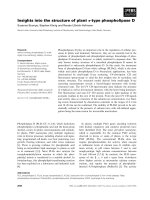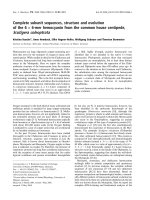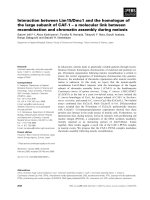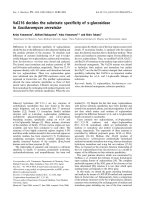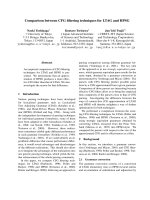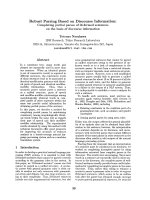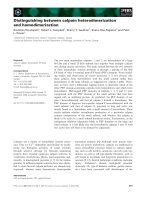Báo cáo khoa học: "Comparison between the structure and function of chloroplasts at different levels of willow canopy during a growing season" ppsx
Bạn đang xem bản rút gọn của tài liệu. Xem và tải ngay bản đầy đủ của tài liệu tại đây (185.16 KB, 4 trang )
Comparison
between
the
structure
and
function
of
chloroplasts
at
different
levels
of
willow
canopy
during
a
growing
season
E.
Vapaavuori
1
A.
Nurmi
2
H. Vuorinen
1
T. Kangas
1
1
The
Finnish
Forest
Research
Institute,
Suonenjoki
Research
Station,
SF 77600
Suonenjoki,
and
2
University
of
Helsinki,
Department
of
General
Botany,
SF-00710
Helsinki,
Finland
Introduction
Light
climate
has
a
strong
impact
on
the
ultrastructure
of
chloroplasts.
There
is
plenty
of
evidence
that
the
degree
of
grana
stacking
in
chloroplasts
of
plants
grown
in
high
light
is
less
than
in
plants
grown
in
low
light
(e.g.,
Lichtenthaler
et
al.,
1981
which
is
also
the
case
for
plants
adapted
to
sunny
or
shady
habitats
(Boardman,
1977;
Aro
et al.,
1986).
Very
little
is,
however,
known
about
the
sea-
sonal
acclimation
process
of
the
photo-
synthetic
apparatus
in
the
canopy,
where
leaves
that
are
initially
exposed
to
full
sun-
light
are
transferred
through
half-shade
into
full
shade.
In
conditions,
under
which
water
and
nutrient
availability
are
not
limit-
ing
growth,
the
shaded
leaves
remain
intact
for
most
of
the
growing
season.
This
suggests
that
the
leaves
retain
a
positive
carbon
balance
by
acclimating
to
the
changing
light
climate.
In
this
study,
we
quantified
the
seasonal
changes
in
the
chloroplast
ultrastructure
at
several
heights
of
a
willow
(Salix
cv.
Aquatica
gigantea)
canopy.
We
also
determined
how
changes
in
chloroplast
ultrastructure
fit
with
their
function
by
measuring
the
rate
of
gas
exchange
under
the
prevailing
envi-
ronmental
conditions
in
the
canopy.
Materials
and
Methods
The
willow
stand
(established
in
1980,
125
m2
in
area)
was
cut
down
before
the
growing
sea-
son
1986
and
measurements
were
made
on
leaves
that
emerged
on
new
shoots
success-
ively
throughout
the
growing
season.
The
stand
was
fertilized
with
a
commercial
fertilizer
(Pu-
utarhan
Y-lannos
10-16-17)
once
a
week
during
the
growing
season,
so
that
it
received
a
total
of
150
kg
of
N/ha/season.
The
stand
was
watered
regularly
to
assure
that
the
plants
were
not
water-stressed.
The
samples
for
electron
microscopic
exami-
nation
were
taken
from
3
replicate
plots
at
6
dif-
ferent
dates
from
upto
5
different
heights
(Fig.
1 A}.
The
samples
were
treated
as
described
by
Vapaavuori
(1986)
and
Aro
et
a/.
(1986).
The
grids
were
examined
on
a
Jeol
100B
electron
microscope.
Before
prefixation
of
the
samples
for
electron
microscopy,
the
photosynthetic
capacity
of
the
leaves
was
measured
at
prevail-
ing
light
and
temperature
conditions
by
means
of
a
C0
2
porometer
(ADC
LCA-2,
the
Analytical
Development
Co.
Ltd.,
U.K.).
The
chloroplast
ultrastructure
was
analyzed
from
the
electron
micrographs
as
described
by
Aro
et
aL,
(1986)
and
Vapaavuori
(1986).
On
an
average,
6
typi-
cal
chloroplasts
were
analyzed
from
each
sample
of
the
3
replicate
plots.
Results
and
Discussion
At
all
studied
levels of
the
canopy,
the
ratio
of
the
total
length
of
appressed
to
non-appressed
thylakoid
membranes
was
lowest
(0.9-1.4)
in
the
youngest
leaves
(Fig.
1 B)
that
were
exposed
to
sun
(Fig.
2B).
The
thylakoid
structure
in
these
leaves
was
similar
to
that
in
plants
adapt-
ed
to
sunny
habitats
or
grown
at
high
20l
PHOTOSYNTHE! I S .
quantum
flux
densities
(Anderson
and
Osmond,
1987).
At
level
1
(60
cm
above-
ground)
the
ratio
increased
slightly
until
the
middle
of
July
(Fig.
1 B),
but
remained
typical
of
sun-exposed
leaves
(below
1.3).
During
this
period,
the
low
rates
of
C0
2
A
uptake
recorded
(Fig.
2A)
were
possibly
caused
by
decreased
availability
of
excita-
tion
energy
in
the
canopy
and
not
by
alter-
ed
organization
of
thylakoid
membranes.
Later
in
the
growing
season,
the
chloro-
plast
ultrastructure
acclimated
to
de-
creased
light
(Fig.
2B)
and
the
low
rates
of
C0
2
uptake
(Fig.
2A)
were
possibly
caused
by
altered
thylakoid
structure
typi-
cal
of
shade
plants
(Lichtenthaler
et
aL
1981
Part
of
this
reorganization
in
thyla-
koid
membranes
might
also
be
due
to
ageing,
since
the
area
of
plastoglobuli
of
chloroplast
area
increased
(data
not
shown),
which
is
known
to
be
an
indication
of
ageing
(Hudak,
1981).
The
pattern
of
thylakoid
organization
at
level
2
(110
cm
aboveground)
was
similar
to
that
at
level
1;
only
the
appressed/non-appressed
membrane
ratio
was
initially
somewhat
higher
than
at
level
1.
Leaves
at
level
3
maintained
high
rates
of
C0
2
uptake
throughout
the
7
wk
period
under
examination
(Fig.
2A),
although
the
quantum
flux
density
decreased
markedly
(Fig.
2B).
The
thylakoid
structure
was
typi-
cal
of
sunny
habitats,
since
the
ratio
of
the
length
of
appressed
to
non-appressed
thy-
lakoid
membranes
remained
below
1.4
(Fig.
1 B).
The
leaves
examined
from
levels
4
and
5
were
physiologically
young
and
the
rates
of
C0
2
uptake
recorded
were
from
intermediate
to
high
(Fig.
2A).
The
ratio
of
the
length
of
appressed
to
non-appressed
thylakoid
membranes
was,
however,
quite
different
(Fig.
1 B).
One
might
speculate
that
the
high
ratio,
1.5,
in
chloroplasts
at
level
4
was
due
to
the
late
season,
as
suggested
by
Aro
et al.
(1985).
This
argument
is,
however,
not
valid
for
the
somewhat
younger
leaves
at
level
5,
which
had
developed
under
similar
clima-
tic
conditions
but
had
a
lower
rate
of
C0
2
uptake
and
an
appressed/non-appressed
membrane
ratio
of
about
1.
In
the
present
study,
a
negative
correla-
tion
was
found
between
PN
and
the
ratio
of
the
length
of
appressed
to
non-
appressed
thylakoid
membranes
(Fig.
2A)
and
between
the
ratio
of
the
length
of
appressed
to
non-appressed
thylakoid
membranes
and
photon
fluence
rate
(Fig.
2B).
This
suggests
that,
in
the
canopy,
acclimation
of
the
thylakoid
structure
to
decreasing
photon
fluence
rates
will
lead
to
gradual
impairment
of
the
photosynthe-
tic
capacity.
References
Anderson
J.M.
&
Osmond
C.B.
(1987)
Shade-sun
responses:
compromises
between
acclimation
and
photoinhibition.
In:
Photoinhibi-
tion.
(Kyle
D.J.,
Osmond
C.B.
&
Arntzen
C.J.,
eds.),
Elsevier
Science
Publishers
B.V.,
Amster-
dam,
pp. 1-38
Aro
E.M.,
Korhonen
P.,
Rintamaki
E.
&
MAenp5d
P.
(1985)
Diel
and
seasonal
changes
in
the
chloroplast
ultrastructure
of
Des-
champsia
Ilexuosa
(L.)
Trin.
New
Phytol.
100,
537-548
Aro
E.M.,
Rin,[am5ki
E.,
Korhonen
P.
&
Mienpii
P.
(1986)
Relationship
between
chlo-
roplast
structure
and
02
evolution
rate
of
leaf
discs
in
plants
from
different
biotopes
in
south
Finland.
Plant
Cell
Environ.
9.
87-94
Boardman
N.K.
(1977)
Comparative
photosyn-
thesis
of
sun
and
shade
plants.
Annu.
Rev.
Plant.
Physiol.
2Et,
355-377
Hudak
J.
(1981)
Plastid
senescence.
1.
Changes
of
chloroplast
structure
during
natural
senescence
in
cotyledons
of
Sinapis
alba
L.
Photosynthetica’15, 174-178
Lichtenthaler
H.K.,
Buschmann
C.,
DUI
M.,
Fietz
H.J.,
Bach
T.,
Kcrzel
U.,
Meier
D.
&
Rahmsdorf
U.
(1981)
Photosynthetic
activity,
chloroplast
ultrastructure,
and
leaf
characteristics
of
high-
light
and
low-light
plants
and
of
sun
and
shade
leaves.
Photosynth.
Res.
2, 115-141
Vapaavuori
E.M.
(1986)
Correlation
of
activity
and
amount
of
ribulose
1,5-bisphosphate
car-
boxylase
with
chloroplast
stroma
crystals
in
water-stressed
willow
leaves.
J.
Exp.
Bot.
37,
89-98
